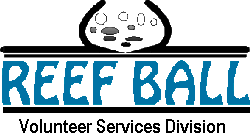

|
Reef Ball Foundation has developed an attachment adapter system that allows for rapid attachment of corals, signs, research markers, plaques, or other items to prefabricated designed artificial reef modules. Clients that own Reef Balls or Reef Ball molds are only allowed to attach corals to Reef Balls using this system or systems approved by the Reef Ball Foundation Coral Team. Additionally, system use requires a current certificate of training from the Reef Ball Coral Team which last for 3 years. They can be renewed by participation in a Reef Ball Coral Team volunteer project, or by having The Reef Ball Foundation provide on-site retraining. |
|
Quick
Artificial Reef
Monitoring and Activities Near You (Reef Ball World Mapping System) |
How the System Works With Corals1. Imperiled corals are gathered and brought to the area of the 'coral prop table' which is placed in shallow water. As they arrive, they are cut into small fragments using special tools and methods. Note: The 'coral prop table' was specially designed by the Reef Ball Foundation to allow corals to remain in healthy water at all times and to make the 'plugging' process fast and efficient. In Antigua, teams of 6 could turn out over 1,000 coral plugs in a day.
3. The concrete is poured into standard 'medicine' cups that have sand in the bottom to allow easy removal of the set plug from the cups.
4. Wearing gloves which are sterilized between each new coral colony worked with, fragmented pieces of coral are inserted into the cement and after 2 minutes they are placed back in the water for full curing which takes 20 minutes before the plug is popped out of the cup.
4.a.) Some corals are placed in a temporary nursery to make sure the plugging process worked correctly before planting.
5. Before planting, they are transferred to trays so the divers can take them to the Reef Balls. 6. Some species must be transported in the trays because they cannot touch each other (Staghorn on the left) whereas other corals can be carried to the reef in buckets or baskets because touch each other is not a problem (Pencil corals on the right).
7. The divers use a special underwater epoxy putty and fit the plugs in to special holes pre-built into the Reef Balls for this purpose. Most corals are rescued, fragmented, plugged, and planted within a few hours. This means they did not have to spend stressful time in an aquarium or other captive environment which is one of the reasons survival rates are so high.
8. A baseline photograph with a reference frame is taken to document the corals progress.
9. After just 3 weeks, you can see the cut parts have overgrown with new coral tissue and buds and if you look closely you can see the coral is starting to grow out over the plug. It will eventually grow out to the Reef Ball and be a permanent part of the reef.
10. After 2 years, these tiny plugs can become very large coral colonies. The above Staghorn coral from the Curacao project is just 20 months old starting with a fragment of less than one inch. |
Want Information About Volunteering & Current
Projects?
Just enter your email address and hit submit
For Attachment Adapter ordering or number to install on a Reef Ball mold click
|
Need more information? Contact us:
|
||
|
|

Reef Ball Foundation, Inc., Georgia Office (Kathy Kirbo) Florida Office (Todd Barber)
|
|
|
Copyright ©1993 - 2004, Reef Ball Foundation, Inc. all rights reserved. See brochure page footer for information on patents, copyrights, trademarks and service marks referenced, but not indicated, on this page. |
Other Valuable Internal Reef Ball Links
Reef
Ball World Mapping System-NEW
-Project Summaries, News, Coordinates, Coordinators, Contractors, ETC by
Location!
News
Articles in the Press
-Maiden
Island Antigua Total Reef Restoration Project Press Release.
-Coral
Reef Transplant Notes
-Identified
Hard Coral Diseases (The
Coral Disease Page) offline